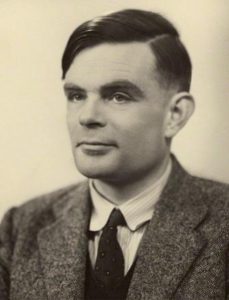

PHI Learning, a trusted name in academic publishing with 62 years of excellence, offers affordable, NEP 2020-aligned textbooks, expert-authored content, and global reach, driving academic progress in higher education.



Alan Turing was a pioneer of machine learning, whose work continues to shape the crucial question: can machines think?
When Alan Turing turned his attention to artificial intelligence, there was probably no one in the world better equipped for the task. His paper ‘Computing Machinery and Intelligence’ (1950) is still one of the most frequently cited in the field. Turing died young, however, and for a long time most of his work remained either classified or otherwise inaccessible. So it is perhaps not surprising that there are important lessons left to learn from him, including about the philosophical foundations of AI.
Turing’s thinking on this topic was far ahead of everyone else’s, partly because he had discovered the fundamental principle of modern computing machinery – the stored-program design – as early as 1936 (a full 12 years before the first modern computer was actually engineered). Turing had only just (in 1934) completed a first degree in mathematics at King’s College, Cambridge, when his article ‘On Computable Numbers’ (1936) was published – one of the most important mathematical papers in history – in which he described an abstract digital computing machine, known today as a universal Turing machine.
Virtually all modern computers are modelled on Turing’s idea. However, he originally conceived these machines merely because he saw that a human engaged in the process of computing could be compared to one, in a way that was useful for mathematics. His aim was to define the subset of real numbers that are computable in principle, independently of time and space. For this reason, he needed his imaginary computing machine to be maximally powerful.
To achieve this, he first imagined there being an infinite supply of tape (the storage medium of the imaginary machine). But most importantly, he discovered a method for setting the central mechanism of the machine, which had to be capable of being set in infinitely many different ways to do one thing or another in response to what it scans on the tape, in such a way as to be able to imitate any possible setting of the central mechanism. The essential ingredient of this method is the stored-program design: a universal Turing machine can imitate any other Turing machine, only because – as Turing noted – the basic programming of the central mechanism (ie the way the mechanism is set) can itself be stored on the tape, and hence can be modified (scanned, written, erased). Thus, Turing specified a type of machine that could compute any real number, and indeed anything whatsoever, that any machine that can scan, print and erase automatically according to a given set of instructions could possibly compute; moreover, to the extent that the basic analogy with a human in the process of computing holds, anything that a human could possibly compute.
It is important to understand that the stored-program design is not only the most fundamental principle of modern computing – it also already contains a deep insight into the limits of machine learning: namely, that there is nothing that such a machine can do in principle that it cannot in principle figure out for itself. Turing saw this implication and its practical potential very early on. And he soon became very interested in the question of machine learning, several years before the stored-program design was first implemented in an actual machine.
As Turing’s Cambridge teacher, life-long collaborator and fellow computer pioneer Max Newman wrote: ‘The description that he gave of a “universal” computing machine was entirely theoretical in purpose, but Turing’s strong interest in all kinds of practical experiment made him even then interested in the possibility of actually constructing a machine on these lines.’
Article reproduced from https://aeon.co/essays/why-we-should-remember-alan-turing-as-a-philosopher
Alan Turing photographed by Elliott and Fry in 1951. Courtesy the National Portrait Gallery, London
PHI Learning books on AI and Machine Learning can be browsed respectively at
https://www.phindia.com/Books/ShowBooks/ODA/Machine-Learning
Our latest publication, “Groundbreaking Inventions in Information and Communication Technology” by V. Rajaraman is an informative and enjoyable read. The book is targeted towards those with a pre-university education and does not require readers to have any prior knowledge on the subject. It aims to provide an overview and historical background of various technological inventions in ICT (Information and Communication Technology) from 1957 to-date.
Rajaraman explains 15 Groundbreaking Inventions in our history, using a uniform and consistent format, divided into 3 categories in accordance with the timeline within which they were created– ‘Between 1957 and 1974’, ‘Between 1975 and 1984’, and ‘Between 1985 and 2011’. Further, each groundbreaking invention is delineated through 2 subheadings: 1) What is the invention? ; 2) Why is it a groundbreaking invention? Alongside this, there are loads of interesting fact boxes and relevant information about the invention, organised in separate sections to educate the
The relevance of the inventions is illustrated as we move through them serially, in the order in which they were invented, from FORTRAN, Integrated Circuits, Relational Database Management Systems (RDBMS), Local Area Network (LAN), Personal Computers, Public Key Cryptography, Computer Graphics, The Internet, Global Positioning System (GPS), World Wide Web, Search Engines, Digitisation and compression of multimedia, Mobile Computers, and Cloud Computing to Deep Learning. Each of these technical terms are broken down and simplified for the benefit of the non-expert enthusiast. Moreover, the technical concepts related to these inventions are explained in a very simple and expressive language so that they are uncomplicated and fun to read.
In the first introductory chapter, Rajaraman explains his reasons for creating this collection of 15 groundbreaking inventions. The author explains, “ICT has spawned a number of new industries that employ millions of people.” He elaborates upon the relevance of ICT and elucidates why it is important for all to have knowledge on the subject. Further, the author provides interesting facts about the history of ICT and introduced readers with ENIAC (Electronic Numerical Integrator and Computer), the first programmable general-purpose electronic digital computer, built in 1946 and UNIVAC (UNIVersal Automatic Computer), the first commercial computer made available in 1951. The author contends that the first groundbreaking invention in ICT was FORTRAN, a high-level programming language, created in 1957, which enabled scientists and engineers to use computers to solve complex problems easily. The chapter contains countless fascinating fun facts.
The subsection “What is a Groundbreaking Invention?” is particularly riveting since it clarifies the concept of a Groundbreaking Invention and defines the term citing authentic sources.
Further, the author lists 8 criteria to classify advancement in ICT as a “Groundbreaking Invention”. These are:
Throughout the book these 8 criteria are used to explain why each of the 15 chosen innovations can be considered groundbreaking. This introduction also features a chronological list of the 15 groundbreaking inventions in ICT from 1957 – 2011.
In the second chapter, “The First Four Inventions”, the author explains FORTRAN, Integrated Circuits, RDBMS, and LAN. The author provides background information about each invention, choosing to tell stories which are interesting and memorable. A fun fact included in this chapter is: John Backus, the inventor of FORTRAN, formed a group of diverse professionals (engineers, scientists, and programmers) to help write the program. For FORTRAN, out of the 8 aforementioned criteria, I found the final criteria, “Societal Impact” to be an excellent measure of its status as a Groundbreaking Invention. The author argues that the code has deeply affected the society we live in.
On Integrated Circuits, the author notes that although the advent of transistors revolutionised electronics, it was soon to be found that building complex circuits with them was not as easy as it seemed. He then provides a detailed explanation of the ideas and experiments which led to the creation of the first integrated circuit. The technical concepts to be used alongside complex terms are written in a simple language and seem to flow into the reader’s mind. The author makes the readers feel as if they are reading a simple story rather than a book full of complex terms. The ‘fact boxes’, included in relevant topics, present thought-provoking information. For example, the section features box items like “How Does a Transistor Function as a Switch” and “How are Integrated Circuits Fabricated?” in a simple and easily understandable explanation blended with excellent diagrams. Next, the author gives reasons for why Integrated Circuits are a groundbreaking invention as per his aforementioned 8 criteria. A noteworthy point amongst these eight is that the invention “Leads to the start of a new industry” — paving the way for the industry of silicon devices and circuits, employing half a billion people worldwide. Later, in a similar format and under the same section headings the author explains RDBMS and LAN, illustrating why these inventions are, in fact, “groundbreaking”.
In the third chapter, the author describes “The Next Five Inventions.” These are: Personal Computer (PC), Public Key Encryption, Computer Graphics, Internet, and GPS. Included in this chapter is a noteworthy box – a biography of Gary Kildall who is best known as the designer of the first operating system for Personal Computers. The book is peppered with such fact boxes which makes the experience of reading about the various technical concepts more interesting. Chapter 3 also contains some compelling and inspiring biographies, such as the biographies of computer wizards Steve Jobs and Bill Gates are written concisely and eloquently, making them more enjoyable to read than the information available online. Another noteworthy section in this chapter is the one on the Apple I, Apple II, and its subsequent models. These were the first computers to feature a keyboard, power supply, and display in their design. These computers also have a memorable name, Steve Jobs, attached to them.
As the author explains why the relevance and historical background of the Internet makes it a Groundbreaking Invention, a very riveting detail in the history of the Internet is mentioned. The author explains the historical relevance of the internet by divulging that the internet was originally created as a defence weapon for the US Department of Defence (DoD). The author states, “J.C.R Licklider was convinced that a country-wide communications network to connect computers would be essential for the defence of the USA.”
Amongst the reasons for why the internet is a groundbreaking invention, the most noteworthy are: 1) It leads to innovations: the internet has provided the format using which further inventions such as Search Engines, the World Wide Web, Video on Demand, Internet Radio, and Cloud Computing have emerged ; 2) Leads to the start of new industries: for example, e-commerce firms such as Flipkart, Search engine companies such as Google, and social networking companies such as Facebook ; 3) Societal Changes: the ability to instantly network with a large number of people online to communicate, consume information, buy, and sell has changed the way our society functions.
Another notable section in this chapter is the one on GPS where the author provides the readers with some interesting facts. For example, the author states “Originally, GPS was intended only for the use of the defence forces of the USA.’ He informs us that GPS is still controlled by the US Department of Defence. He goes on to explain the political effects of this circumstance. This section on the geopolitical effects of the USA’s control on GPS is truly very compelling.
In the final chapter, the author discusses the last six inventions: World Wide Web, Search Engine, Digitization and Compression, Mobile Computing, Cloud Computing, and Deep Learning. He uses the same organised format and easy to read language in this final chapter for clear understanding.
Overall, what I found to be the best feature of this book is the format using which it is organised. The author presents his explanations of and relevant information on 15 groundbreaking inventions in a uniform format which consists of congruously repeating sections with consistent headings for each invention. Personally, the section I found most enjoyable in each chapter was the part where the author explains ‘Why’ – “Why is this invention a groundbreaking invention in ICT?”. This is since it is quite compelling to learn about why the author chose to write about these inventions in the first place. It is eye-opening to know that certain advancements in ICT can be set apart from others and called a “groundbreaking invention”.
Arguably, the author does a commendable job at achieving what he set out to do. He explains the groundbreaking inventions in a simple style to allow anyone with a pre-university education to understand and appreciate how ICT has been developed.
Readers will gain a deep understanding of 15 groundbreaking inventions in ICT from 1957 to-date and will find that this book is not only informative but also an enjoyable read.
I highly recommend this book! Log on to https://www.phindia.com/Books/BookDetail/9789389347524/groundbreaking-inventions-in-information-and-communication